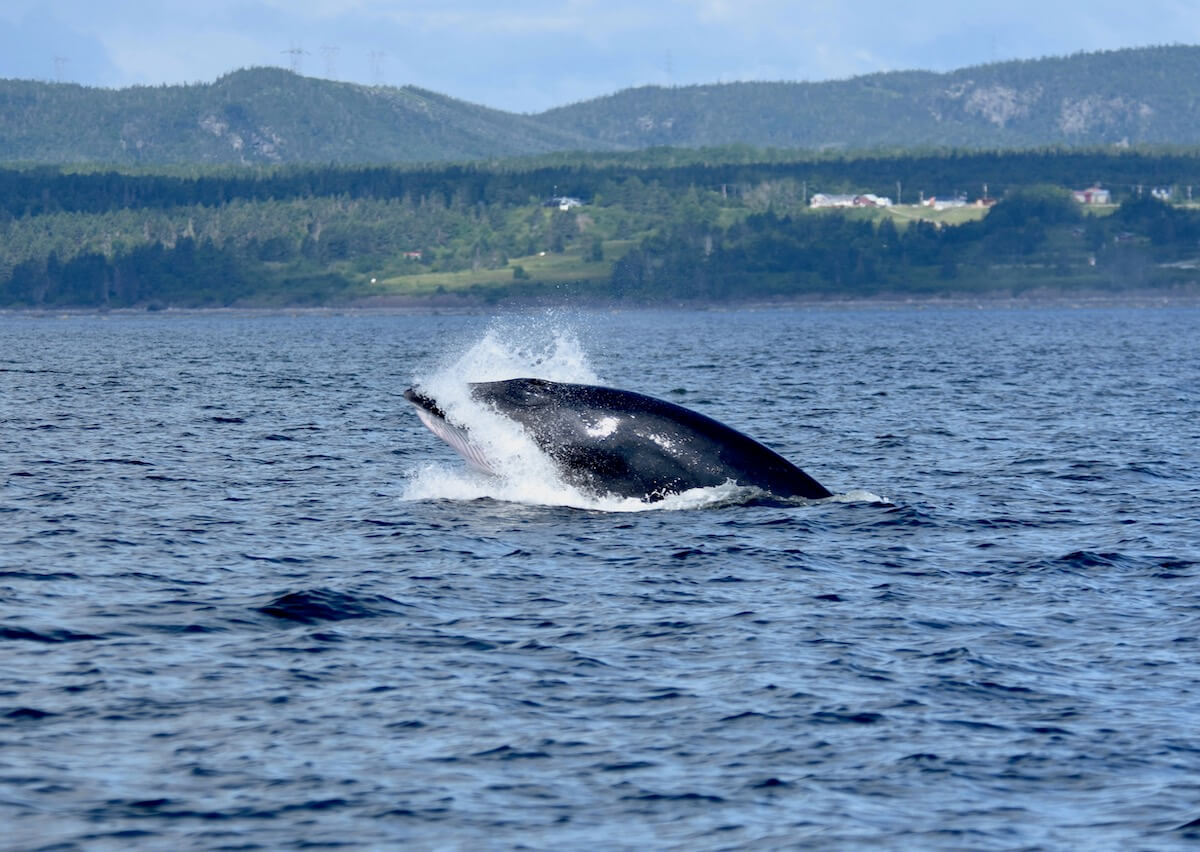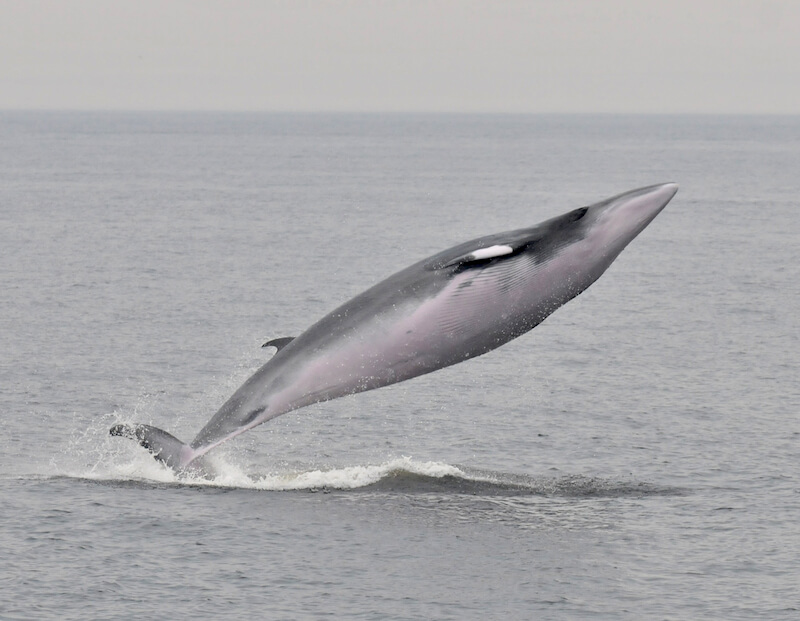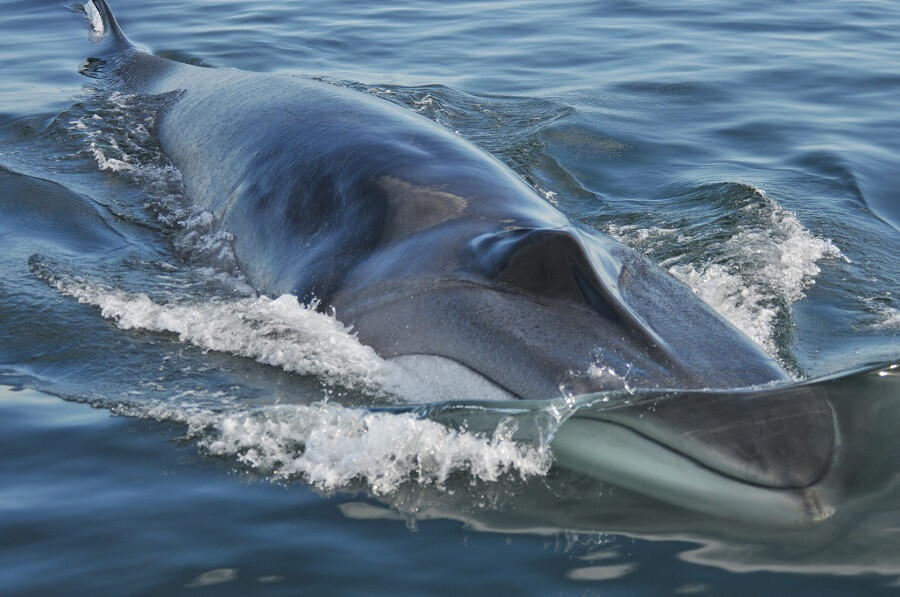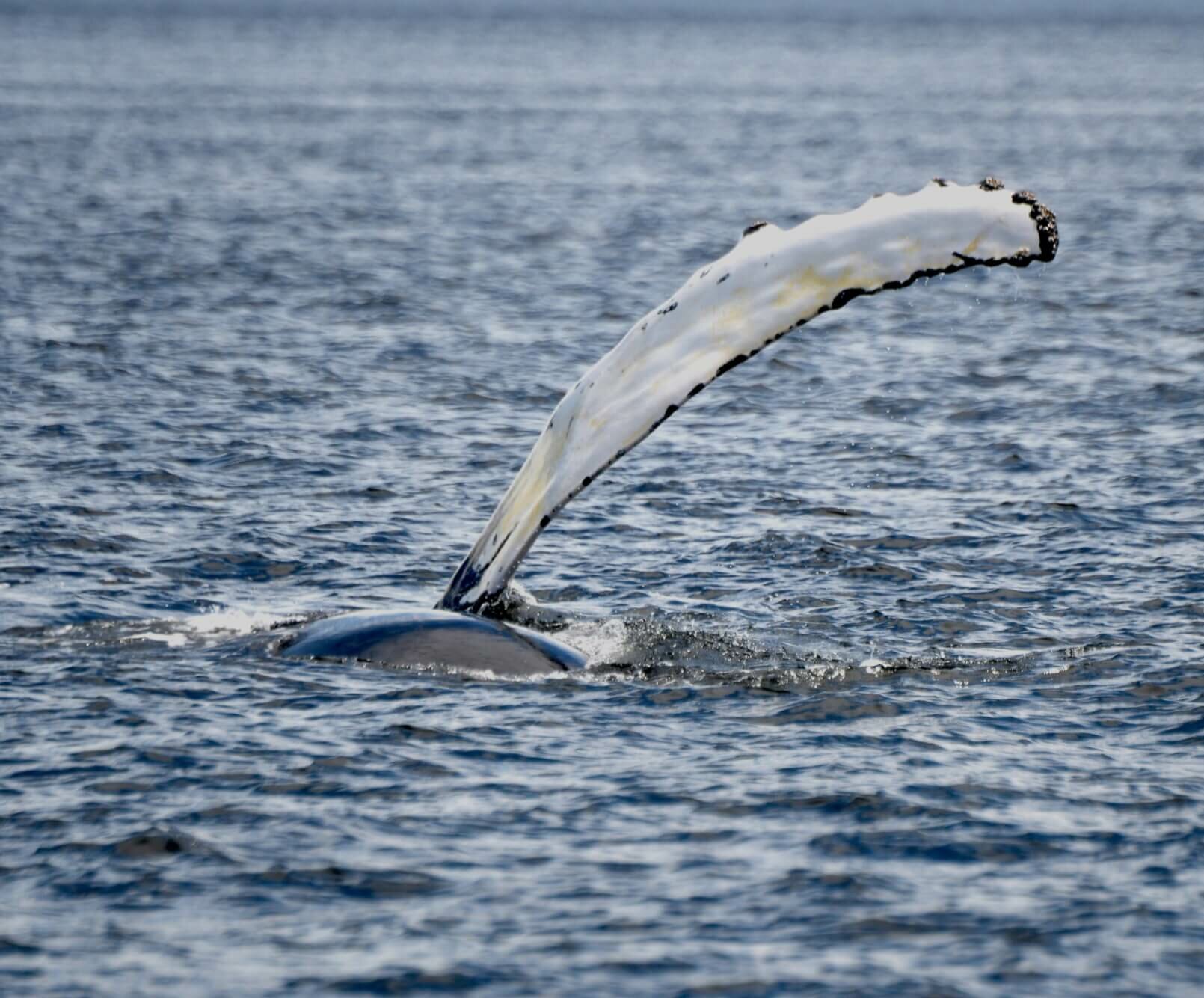Many whales feature both dark body parts and light body parts. This is the case for a number of species that frequent the St. Lawrence River such as minke, humpback and fin whales. The killer whale – an extremely rare visitor – also falls into this category. Why do certain whales have this characteristic?
Minke Whale Spots Spark Several Theories
The colouring of minke whales harbours somewhat of a mystery. In the species’ North Atlantic population, all individuals show white patches on their pectoral fins. Could there have been crossbreeding between the populations of different regions, one of which might have transmitted the gene for the white spots to the individuals of the North Atlantic? There is a subspecies that has almost all-white fins – the dwarf minke whale – and a related species, the Antarctic minke whale, which has completely black fins. Could this feature be an adaptation to the animals’ living environment?
According to another hypothesis, the spots on the pectoral fins of minke whales could serve as lures to attract prey, much like those used in sport fishing. On study suggests that the white on several parts of their bodies might play a role in catching fish, krill and squid. The white patches might also be used for communication between individuals of the same species. In fact, these markings are associated with a gregarious social life, rapid swimming and flamboyant behaviour at the surface. Conversely, such colouration does not seem to be linked to intraspecific (between species) communication. According to the same study, the distinctive markings could be associated with lightweight species, which supports the hypothesis that they act as a lure to avoid predators.
Variation in Humpback Caudal Fins
Tail fin pigmentation is a product of genetics and, occasionally, on events that leave white scars such as barnacles, killer whale attacks, and entanglements. Variations have been observed around the world: some populations of humpbacks have a greater proportion of predominantly white or black tails. The same phenomenon is observable in humans, for example in the variability of our eye or hair colour.
As for humpback whales living in the Atlantic, individuals found in the Gulf of Maine have black tails more often than those that visit other foraging areas such as the St. Lawrence. However, researchers are of the opinion that the humpbacks of the Northwest Atlantic interbreed with those of Maine, and therefore form a single population. The fact that the proportion of two-tone patterns is not the same at all feeding sites appears to contradict this hypothesis, but this is not the case. In humpback whales, tail colouring is mainly inherited from the mother, who passes on to her calf her knowledge of the feeding grounds she frequents.
Lastly, researchers noted that the colour of the caudal fin can depend on the sex. Indeed, the tails of females are usually darker than those of males. Thus, a significant difference was observed between individuals near Virgin Bank in French Polynesia and those off the shores of the Dominican Republic. In the Virgin Bank population, there is a greater proportion of predominantly white caudal fins. Similarly, individuals frequenting the Gulf of Maine often have mostly white tails as well.
A Matter of Adaptation
The caudal fin is not the only part of a humpback’s body whose colour varies between individuals or populations. The underside of the pectoral fins is white, as may be the top as well. This is believed to be an example of the countershading principle, also known as Thayer’s law. A well-known adaptation in biology, it is found not only in fish (e.g. mackerel and sharks) and whales, but also in reptiles, mammals (e.g. squirrels), birds (e.g. penguins), etc. In these animals, the lower parts are lighter than the upper parts, creating a sort of camouflage. This is because a uniformly coloured animal that is lit from above appears brighter above than it does below. Countershading compensates for this phenomenon and ensures that, when viewed from the side, the animal is not overly conspicuous.
This adaptation helps whales avoid their predators, as most cetacean species can be prey for other species. The minke whale, for example, is hunted by the killer whale. The fact that it is light below and dark above is believed to help it go unnoticed. Moreover, the study The functional significance of colouration in cetaceans shows that the countershading mechanism is used by smaller whale species. Countershading is also useful for hunting. Thus, the fin whale’s caudal fin is white below, as are its fins.
Additional Advantage for the Fin Whale
The fin whale has yet another unique feature: Its left jaw is dark while the right side is light. Indeed, most whales are “righties.” When a fin whale rolls onto its side to feed, prey above associate its dark side with the depths of the sea and do not try to flee. According to the same principle, prey swimming below mistake its white side for the water surface. In this regard, the aforementioned study The functional significance of colouration in cetaceans demonstrated that species with asymmetric lower mandibles were significantly more likely to be predators of fish or squid.
Humpback Pectorals as Decoys
Humpback whales can use their white pectoral fins to frighten fish away. They position themselves so that their pectorals reflect the light. The prey therefore “seek refuge” in a dark place, namely the whale’s mouth! According to one study, one whale only used this technique when the light reaching the surface was sufficient. Previously, an experiment had shown that farmed fish swam away whenever they saw imitation humpback whale fins.
Unique Killer Whale Camo Ideal for Hunting
Killer whales are black and white in order to confuse their prey. Indeed, their colour patterns break up their silhouette. Furthermore, this camouflage is also rendered effective by another element. Indeed, the sun creates reflections on the water, especially in winter when drifting ice is present. Similar reflections can be observed on the white spots of killer whales, which helps these animals blend in with their surroundings in the colder months. Additionally, killer whales’ light spots may help them find their way, coordinate with one another and hunt when the water is dark or murky. In fact, each individual has a distinct teardrop-shaped spot in front of the eye (the shape and size of which vary from one population to another). These eye patches are extremely deceptive. Animals such as seals or sharks that fall victim to killer whales may attempt to reach the latter’s eyes to cause them pain and force the predators to let them go. However, killer whales’ eyes are actually located behind these spots: the hunters therefore have nothing to fear!
As we can see, a number of the cetacean species that frequent the waters of the St. Lawrence are two-tone due to genetics or adaptation.
Learn more:
- 2005, Richard, P., et Prescott, J., Découvrir les baleines et autres mammifères marins du Québec et de l’Est du Canada, Canada, p. 124.









